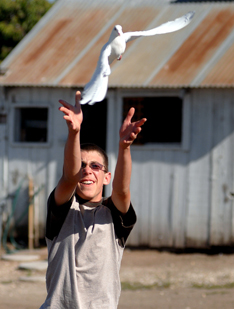
Local student uses love of birds to earn a trip to state science fair
John German is not your typical 12-year-old boy.
There are, of course, hobbies and habits he shares with other boys his age. He enjoys sports and loves shooting hoops in his backyard; he likes teasing his younger sister and brother and hanging out with friends.
Then there are the favorite pastimes that set John apart from his peers – raising homing pigeons and growing 600 pound pumpkins, to name a few.
“My dad has some really cool hobbies and he’s a lot of fun to hang out with,” John said. “I think I picked up a lot by hanging out with him.”
John, who will enter seventh grade at Tres Pinos School in August, recently competed in the California State Science Fair with a project based on the flight patterns of the homing pigeons his parents, Mike and Shannon, raise as part of their business venture, Central Coast Dove Releases. Mike German has raised pigeons since he was 12 years old, and has passed that passion on to his wife and three children.
While searching for a topic for his science fair project this past school year, John came up with the idea of using the pigeons as a test subject. Rather than use already researched data, John came up with his own theory – does temperature affect the flight patterns of homing pigeons – and went about testing it.
“The point was to see if the pigeons would fly faster in cooler or warmer temperatures,” he said. “I decided the only way to control that variable was to do one release in the morning and one in the late afternoon. My mom helped me and we did the project twice a day over four days.”
Each day of the experiment, the family drove five miles to the nearby ranch where the Germans house their birds and pack up the single pigeon John selected for his project. John stayed behind at the ranch, while Shannon drove back to their house with the bird. Just at the time of release, she called John, who would then time how long it took for the bird to find its way back to the ranch.
“The average time in the morning was about 25 minutes, and the average afternoon time was around eight minutes,” John said. “I determined the birds fly faster in warmer temperatures.”
John wrote up his research on his own and created a project summary on a story board. His project took third place in the zoology category for sixth graders at the school level, which automatically entered him in the county science fair, where he placed first in his category among all middle school entries.
“I don’t think the judges at school were bird lovers,” he said with a small smile on his face.
His first place county win allowed his project to be considered as one of six possible entries at the state level. Upon learning of his selection for state, John asked his mother if they could make the trip to the University of Southern California to attend the fair.
“It was pretty amazing,” he said. “The projects were set up in this huge arena were they used to play basketball, and there were just rows and rows and rows of projects. There were like 900 entries, and there were so many people there.”
Even though John did not win at the state level, he said he is glad for the experience.
“A lot of the projects were on topics that could help us in the future, such as helping the environment or changes to agriculture,” he said. “Those were the ones that were winning and the ones really getting recognized. It was good for me to see what types of projects were the ones the judges liked because I already have an idea for a project for next year.”
An agricultural project would be a natural choice for John, who says he enjoys gardening and growing vegetables. Last year, John – along with his sister, Holly and brother, Joshua – grew giant pumpkins, which John and Holly entered in the San Benito County Fair. John’s 639 pound pumpkin took first place in his category, earning him $100, while Holly’s almost 400-pounder earned her first place in her age group and $75. Joshua chose not to enter his pumpkin in the fair, so the family carved it for their front yard instead.
“My pumpkin could have won at the adult level – it was heavier than the biggest one entered in that category by 400 pounds,” he said. “It took six men plus my dad to lift my pumpkin into the truck.”
The three German children planted this year’s pumpkins last month, and have already built small wind breaks around the mound of dirt which covers the seeds.
“It takes a lot of dedication to grow big pumpkins,” John said. “You can’t let it dry out, but you can’t overwater it either. You have to protect it from the wind and too much sun.
John continues to work with birds, although his allergies prevent him from spending as much time as he would like with them. He is allowing his idea for next year’s science fair project to germinate in his head (“The winner in the agricultural division got a $5,000 scholarship, so that could be pretty cool”) and is looking forward to entering his giant pumpkin in the 2008 county fair.
When he’s not out shooting hoops, that is.









